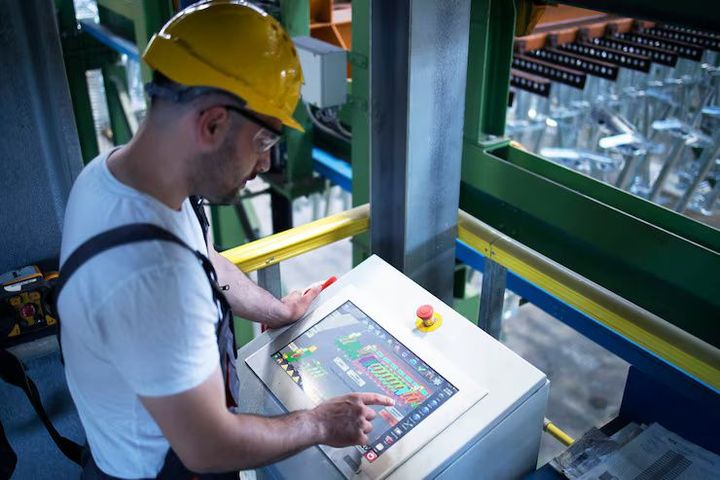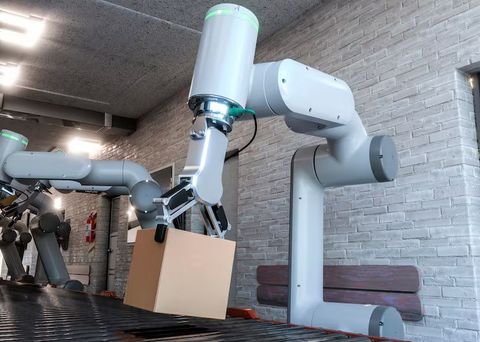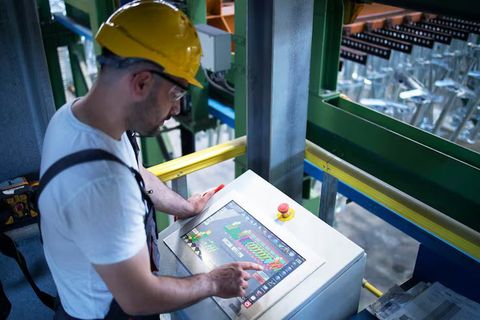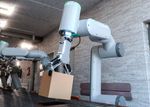In an industrial setting, sensors sit at the interface between the physical world (motions, forces, temperatures, chemical levels) and the digital/control world. They provide the data which enables control systems, analytics platforms or human operators to act. As manufacturing, utilities, infrastructure and other sectors become more automated, the role of sensors has grown accordingly.
 Importance
Importance
Why do industrial sensors matter today, and for whom?
-
Manufacturers, process plants, infrastructure operators: They rely on sensors to monitor equipment condition, ensure product quality, maintain safety and reduce unplanned downtime.
-
Maintenance and reliability teams: Sensors feed data for predictive maintenance—detecting faults early, avoiding costly breakdowns.
-
Quality control and compliance: Sensors measure variables (e.g., temperature or humidity) that affect regulatory compliance or product quality.
-
Automation and Industry 4.0 initiatives: As operations shift to more interconnected, “smart” systems, sensor networks are foundational. Trend reports project global industrial sensor markets growing at 7 %-10 % + annually.
-
Energy, environment and safety: Sensors enable monitoring of emissions, vibrations, structural health, contributing to sustainability and worker safety.
Problems that sensors help solve include: lack of visibility into equipment health, delayed detection of faults, inefficient use of assets, inability to meet regulatory or quality standards, and inability to scale data-driven operations.
A simple table of key benefits vs typical problems:
| Problem Without Sensors | Benefit With Sensor Deployment |
|---|
| Unscheduled breakdowns, reactive maintenance | Early fault detection, planned maintenance |
| Poor product quality or batch inconsistencies | Real-time monitoring of critical parameters |
| Manual checking and limited data | Automatic data capture, trend analysis |
| Lack of visibility into remote or harsh‐site conditions | Remote monitoring, alerts, better decision making |
| Difficult to demonstrate compliance or safety | Logging of measurable parameters, audit-readiness |
Recent Updates
In the past year (2024-2025) several important developments have emerged in the industrial sensor domain:
-
Smart sensors with on-board intelligence, edge-analytics and wireless connectivity have become more mainstream. A report from October 2025 noted that sensors integrated with AI and IoT are “the backbone of smarter, safer, more efficient systems.
-
The global industrial sensors market is forecast to expand significantly: for example, one report predicts a value of about USD 25.68 billion in 2025 and reaching USD 45.28 billion by 2032 at a CAGR of ~8.4 %.
-
In the India context: the Indian industrial automation sensors market reached about USD 0.75 billion in 2024 and is projected to grow to USD 1.61 billion by 2033 (CAGR ~8.8 % from 2025-33).
-
Manufacturers are increasingly focused on standardized connectivity protocols (e.g., for interoperability), wireless sensor networks, edge computing rather than purely cloud-based analytics.
These trends signal that sensor deployment is no longer just about measuring a parameter—it’s about integration, data, connectivity and actionable insight.
Laws or Policies
In the Indian context, relevant rules, standards and government programmes that affect industrial sensors include:
-
The Make in India initiative encourages manufacturing of electronics and components (including sensors) domestically.
-
The partnership between Electronics City Industries Association (ELCIA) and India Electronics & Semiconductor Association (IESA) aims to boost sensor manufacturing capacity and reduce dependence on imports.
-
The Telecom Regulatory Authority of India (TRAI) in April 2025 recommended bringing M2M/IoT devices (which would include sensor networks) under the “Trusted Source / Trusted Product” regulation for critical infrastructure sectors, emphasising device origin, security and supply‐chain trust.
-
Standards: Various manufacturing and product standards apply. For example the Occupational Safety, Health and Working Conditions Code, 2020 (which replaced the Factories Act) governs health and safety in workplaces and by extension equipment used in industrial establishments must meet safe operational standards.
-
The call for a sensor manufacturing common facility in India: Centre for Materials for Electronics Technology (C-MET) in Kerala issued an Expression of Interest (EoI) for a Sensor Manufacturing Common Facility Centre under the aegis of the Ministry of Electronics and IT, indicating government‐backed infrastructure for sensor production.
In summary: while there is no single “sensor law,” deployment and manufacture of industrial sensors is influenced by manufacturing policy, electronics sector policy, IoT/M2M device regulation, workplace safety and manufacturing standards. For a practitioner, compliance with relevant standards (e.g., safety, electromagnetic compatibility, explosion‐proof ratings in hazardous locations) and aligning with government manufacturing initiatives can be important.
Tools and Resources
Here are helpful tools, resources and platforms to support understanding, selection and deployment of industrial sensors:
-
Websites and market-insight platforms: For example, industry market reports on “Industrial Sensors Market Analysis & Forecast” show segmentations by sensor type, region, and growth drivers.
-
Technical blogs and guides: An article titled “Choosing Industrial Grade IoT Sensors for Indian Manufacturing” (Oct 8 2025) guides on factors like environment, connectivity, protocol, calibration, and lifecycle.
-
Standards and certification references: Organisations such as Bureau of Indian Standards (BIS) set national manufacturing standards; certification blogs explain safety (e.g., SIL certification in India for industrial sensors).
-
Project templates and check-lists: While there is no single universal template, useful checklists might include: sensor selection (type, range, accuracy), environment (temperature, humidity, vibration), connectivity/protocol (wired vs wireless, power source), calibration schedule, cybersecurity (for IoT sensors), integration with SCADA/MES.
-
Software and analytics tools: Platforms that integrate sensor data (via industrial IoT gateways) enable trend-analysis, alarms/alerts, dashboard visualisations. While specific names vary by vendor, looking for support of open protocols (e.g., OPC UA, MQTT) is advisable.
-
Training and standards bodies: Participation in industry associations (for example sensor manufacturing trade groups) may provide workshops or guidelines on best practices around sensor installation, calibration, environment selection.
-
Government support portals: For India, manufacturers may explore incentives under electronics manufacturing or PLI schemes, or view EoIs such as that published by C-MET for sensor manufacturing facilities.
By combining technical selection, deployment best practices and awareness of policy/standards, organisations can use sensors more effectively.
FAQs
Q1: What are the common types of industrial sensors and what do they measure?
A: Some typical types include:
-
Temperature sensors (thermocouples, RTDs) measuring heat in processes.
-
Pressure sensors (measuring gas or liquid pressure inside vessels or pipelines).
-
Flow sensors (measuring volume or mass flow of fluids).
-
Proximity/position sensors (detecting object presence or distance).
-
Vibration sensors (measuring machine vibration to assess condition).
-
Level sensors (measuring material or liquid level inside tanks).
-
Image/vision sensors (detecting defects visually or inspecting surfaces). Reports show pressure sensors lead the market share in 2025, about 25% by value.
Q2: How should one choose industrial sensors for a harsh environment (dust, heat, vibration)?
A: Key considerations include:
-
Environmental ratings: IP65/IP67 for dust/water protection; appropriate voltage range and shock/vibration resistance. For example, industrial grade sensors should handle –40 °C to +85 °C if needed.
-
Mounting and housing: Ensure sensor mounting is appropriate (e.g., vibration isolation if on rotating machines).
-
Calibration and accuracy: Choose sensors whose accuracy and repeatability meet application needs; check their calibration schedule.
-
Connectivity/protocol: Ensure the sensor supports the communication protocol your system uses (wired, wireless, industrial fieldbus or IoT).
-
Maintenance and lifecycle: Consider sensor durability, spare parts availability, and ease of replacement.
Q3: What role do sensors play in predictive maintenance?
A: Sensors continuously monitor equipment parameters (vibration, temperature, acoustic signatures, etc.). When combined with analytics, the data can identify trends that precede failure (e.g., increasing vibration amplitude or temperature drift). This allows maintenance to be scheduled proactively rather than waiting for breakdowns. Many reports cite predictive maintenance as a key driver of sensor demand.
Q4: What are some of the challenges when deploying sensor networks in industrial settings?
A: Challenges include:
-
Integration with legacy equipment and control systems (compatibility issues).
-
Data overload—many sensors generate large volumes of data which must be managed, stored and analysed.
-
Calibration drift and sensor failure—sensors need to be maintained to remain reliable.
-
Connectivity and power supply issues—especially for wireless or remote sensors.
-
Cybersecurity risks—IoT sensors may become entry points for attacks if not properly secured. Reports highlight increasing focus on device security and supply-chain trust.
Q5: What should be the first step for an organisation considering deployment of industrial sensors?
A: The first step is usually a needs-assessment, which involves:
-
Identifying key processes or equipment that would benefit from measurement and monitoring.
-
Defining which parameters (temperature, vibration, flow, etc.) truly impact performance, safety or compliance.
-
Evaluating environmental and operational constraints (e.g., extreme temperatures, dust, accessibility).
Once this is clear, you can move on to selecting sensor types, connectivity, integration plan, and maintenance strategy.
Conclusion
Industrial sensors play a foundational role in modern manufacturing, process industries and infrastructure operations. They bridge the physical and digital worlds, enabling monitoring, control, optimisation and safety. With trends such as IoT connectivity, edge analytics, wireless networks and smart manufacturing accelerating, sensor deployment is becoming ever more strategic.
In regions such as India, policy initiatives like Make in India, electronics manufacturing support, and regulation of IoT/M2M devices all shape how sensors are manufactured, deployed and managed. For operators and decision-makers, success hinges not simply on purchasing sensors, but on selecting the right types for the environment, ensuring compatibility and connectivity, integrating them into analytics workflows, maintaining them properly, and aligning with standards and regulatory frameworks.
By combining careful planning, the right technology and attention to lifecycle and integration, organisations can make the most of industrial sensors to improve visibility, reliability, efficiency and compliance—without being overwhelmed by the data, infrastructure or security challenges

 Importance
Importance









